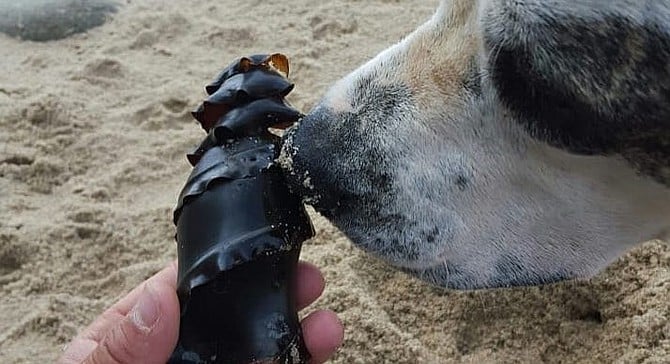 Facebook
Facebook
 X
X
 Instagram
Instagram
 TikTok
TikTok
 Youtube
Youtube

If you find what looks like a corkscrew along the beach, you’ve most likely stumbled upon a horn shark egg.
Mating season for horn sharks generally occurs in December or January and from February through April, the females lay up to 24 eggs, 2 at a time, once every 11-14 days.
Each egg, or spiral encasement contains a single embryo and a yolk sac.
“The mother will push them between rocks to ensure their safety so they can hatch,” Christian Fisher said after finding one on shore in Ocean Beach. “Occasionally they get loose and end up on shore before they hatch which is why it's important to know that if you find one it needs to go back into the water as deep as you can get it, with as little motion as possible.”
The eggs are laid by the females in water anywhere between six to 42-feet deep, and can take several hours to deposit. Then using their mouths, they pick them up to wedge into crevices for safety. This makes them one of the few sharks to exhibit parental care.
Initially, the case is soft and light brown, after a few days it hardens and darkens in color. Not including the spiral flanges, the case measures 3.9–4.7 inches long and 1.2–1.6 inches wide.
The corkscrewed egg-casings take six-eight months before hatching, with the newly hatched sharks being born with an internal yolk sac giving them about a month's supply of food, although they do have the ability to feed during this time.
“We walked it out as far as we could go and set it back into the ocean,” Fischer explained. “There's a tiny living being inside who still isn't ready to come out and it needs to get back to the water to finish growing before it can take on the sea. So grateful I had this experience today with such a rare and precious find.”


If you find what looks like a corkscrew along the beach, you’ve most likely stumbled upon a horn shark egg.
Mating season for horn sharks generally occurs in December or January and from February through April, the females lay up to 24 eggs, 2 at a time, once every 11-14 days.
Each egg, or spiral encasement contains a single embryo and a yolk sac.
“The mother will push them between rocks to ensure their safety so they can hatch,” Christian Fisher said after finding one on shore in Ocean Beach. “Occasionally they get loose and end up on shore before they hatch which is why it's important to know that if you find one it needs to go back into the water as deep as you can get it, with as little motion as possible.”
The eggs are laid by the females in water anywhere between six to 42-feet deep, and can take several hours to deposit. Then using their mouths, they pick them up to wedge into crevices for safety. This makes them one of the few sharks to exhibit parental care.
Initially, the case is soft and light brown, after a few days it hardens and darkens in color. Not including the spiral flanges, the case measures 3.9–4.7 inches long and 1.2–1.6 inches wide.
The corkscrewed egg-casings take six-eight months before hatching, with the newly hatched sharks being born with an internal yolk sac giving them about a month's supply of food, although they do have the ability to feed during this time.
“We walked it out as far as we could go and set it back into the ocean,” Fischer explained. “There's a tiny living being inside who still isn't ready to come out and it needs to get back to the water to finish growing before it can take on the sea. So grateful I had this experience today with such a rare and precious find.”
Comments